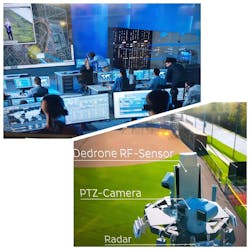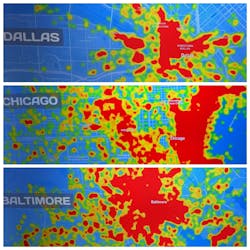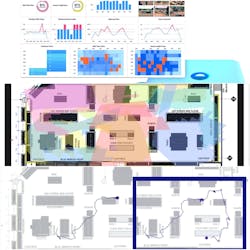From drones to star trails, ChatGPT AI innovations create buzz at ISC West 2023
In spite of all the controversy that has emerged, the capabilities that artificial intelligence (AI) tools are providing to the security industry were a dominant topic of conversation among attendees and in exhibitor booths at ISC West this year.
Several exhibitors have leveraged Open AI ChatGPT’s ability for fast and accurate decision making and power to observe trends over days, weeks and months in ways that might be overlooked.
This is the augmentation (as compared to automation) described in SecurityInfoWatch.com coverage of AI processing tools in previous ISC West events. This ostensibly would lead to a workforce making better decisions on their duties, such as offloading the burden of false-alarm processing for example.
AlertEnterprise revealed its first-ever Guardian AI Chatbot powered by ChatGPT, debuting it at the ASIS Europe and ISC West trade events. And here, Dedrone and Dragonfruit AI explained to SecurityInfoWatch.com how the technology can work for security professionals.
Faster Decision Making
To better understand how security, life safety and operations management solution providers at ISC West are leveraging AI’s accelerated decision making – using complex images, audio and language inputs -- SecurityInfoWatch.com began tracking ChatGPT’s development.
In March 2022, OpenAI released the GPT-3.5 Neural Network. Since then, both users and developers have leveraged the large language model via ChatGPT, its chatbot user interface. Here’s an example of how this works:
Developer: “The image ****.png is an image of a retail store interior. Remove the people in the image and replace them with adjacent objects for continuity.”
Visual ChatGPT: “I’ve removed all the people and replaced them with adjacent objects.”
Developer: “Good. The images ****.png ****.png ****.png are people standing still. Place them at equal distances from each other, with the first, adjacent to the object that looks like a cash register.”
Visual ChatGPT can understand human intentions, language, place, edit images and analyze a complex scene. In the case above, the developer is creating basic, synthetic data of a queue line at a store checkout.
Now imagine the reverse process, where a progression of complex images from a video stream is quickly analyzed over a significant period and the results summarized for an executive to read.
OpenAI’s newly released GPT-4 has learned from significantly larger amounts and types of data, analyzing, summarizing and answering complex questions about a wider range of topics, making it a significantly more valuable tool for developers of real business intelligence, security and tools.
According to OpenAI, GPT-4 cannot duplicate human reasoning, but it can estimate what would be valuable to an executive, rapidly processing attempts at human intention and incorporating feedback. Right there, ISC West attendees experienced a preview of GPT-4’s useful ability to deliver descriptions, conclusions and security situation awareness.
Drone Detection as a Service
The transformation of Dedrone’s solutions into service offerings based on advanced neural networks brings affordability without compromise back to practitioners, agencies and critical infrastructure management.
Mary-Lou Smulders, Dedrone’s Chief Marketing Officer, leveraged her aerospace engineering background and rapid cross-industry AI, cloud and ICT infrastructure advancements.
The core of Dedrone’s solution is drone tracker software that uses two kinds of AI machine learning. This is the one that people are familiar with, she says. It’s imagery-based machine learning, where over the years we've gathered over 18 million images that we've tagged as birds, helicopters, whatever it may be.
“Ahead of that we have three layers of databased machine learning, where we use different filters and algorithms, including convolutional networks, to answer two very simple questions: ‘Is it a drone?’ and ‘Where exactly is the drone?’” says Smulders. “That becomes important when you think about the back end of the spectrum and being able to use our solution to automatically mitigate the drone.”
Dedrone has deployed drone detection and communication alerts in 38 cities across the U.S., and the company expects to have 60 sometime in June.
The company offers drone detection as a service, either on a PC or in an SOC or as an app on iOS or Google Play, deploying it in one of three ways.
The true drone detection as a service is a trailer-based solution with a complete sensor head that includes true multi-sensor fusion, which is offered mostly to police departments and first responders who need drone detection capability in different locations. Another option is what Dedrone calls “fixed site,” for area that is not moving.”
Dedrone layers long-range RF detection cameras connected to the (for example) DJI drone tracker solution. Additional sensing is complemented by GPS receiver, radar modules and other emission layers as needed.
Sensor fusion makes the system more robust by mitigating false detections of the individual sensors, so users see payload or, alternatively, get “eyes on the pilot.”
Dedrone provides color-coded heat maps of cities where hardware-free software as a service is available.
Smulders wraps up our conversation of the fast-deploy model: “You get a map, draw a perimeter of the airspace that you care for, such as an airport, refinery or prison, and you want that multi-layer fusion capability. That's the way you would go and then you could show it on your SOC.”
‘Star Trails’ Creates Customer Journey
Recognizing that the GPT Neural Network is advancing, Amit Kumar, Dragonfruit AI CEO and founder, introduced Star Trails, which provides large enterprises with multiple locations a central view of all their physical security via a unique “split-AI” cloud forensics platform, balancing AI resources automatically between edge-AI devices and cloud resources.
Kumar, a holder of 20-plus patents, has significant experience with customer-faced solutions, leveraging powerful analytic engines through companies like Lexity (bought by Yahoo) and Yahoo Web Search, a multi-billion-dollar engine through Yahoo SearchMonkey.
Kumar offered a glimpse to the inner workings of their intelligence solution, first describing the technology’s ability to create “customer journeys.
“Imagine people walking in your environments as stars, and you take any number of cameras that you have and can isolate so you can search for people,” Kumar says. “And then any given person that you find in your environment, you can click on them and, say, create a customer journey.
“That will identify them across all the cameras available, stitch a storyboard together and run that through. In addition to having this A storyboard, we have all those cameras together into a top-down view, with a floorplan, that shows you that trail together with the camera views. This allows a retail professional or security professional to see the behavior. That's the path of the stars.”
During the demonstration, we were presented with a unique, real-time infographic: the human Star Trails, a floor plan with layers of details from the retail rich data, and most significantly, a summary in plain English of the behaviors and projected results, suitable for direct reading by a CEO or board member.
This is a real-world interaction the next generation of a public-facing ChatGPT would make, if presented with carefully selected, hierarchical parameters.
In retail environments, “this is really, really helpful for marketing teams who might have a new product or new showcase understand how people are interacting with it, enjoying it,” Kumar says. “For security professionals, imagine identifying a person that shows up, gets out of their car, goes through the mall interested, or comes out and does other things like steal products.
“This is a classic problem that every operator knows takes hours and hours of work. A lot of these investigations end up getting abandoned because you don’t realize you're skipping 16 acts, and you're missing events. With our system you never do. The problem with (legacy VMS) search is it dumps a bunch of results out of multiple cameras and you must somehow make sense out of it. With Star Trails, there is a whole storyboard view."
Understanding that the use of a GPT engine is only as good as the parameters and data used, Kumar says Dragonfruit AI realized they needed to simply receive and organize as much as possible. They announced a product that picks up all a user’s cameras and centralizes all the data.
“These are true behavioral search functions. People talk about business intelligence, but this is usable information,” he says.
Finally, Amit describes the delivery of understandable intelligence and human pattern recognition across all the facility cameras. The company has come up with a solution to help users understand behavior in particular zones, such as whether more people are visiting a store area that has been remodeled.
“The problem, we found, was that it’s a sea of information. We’re now leveraging GPT to give you executive summaries of what you need to know on a store level. It will tell you that in your furniture store, your bedroom section had 20% more traffic than last week, but 5% less than a typical Sunday,” Kumar says. “That’s something interesting I can use. And the regional guy, for example, gets a different report and the CEOs get a report about what stores are doing well.”
Direct, Bottom-Line Savings
He notes this all ties together by taking something at a price point and making it possible for people to deploy it at scale, analyzing the data and providing it to executives who need information in a digestible way.
“That's where the GPT integration comes in,” Kumar says. “This is direct, bottom-line savings and that’s helpful for a loss prevention professional, a business or a marketing person that actually writes the checks who must justify sales.”
Despite the perceived threats of an advanced AI that replaces humans, the ability to augment, not replace human security is easily seen. Hundreds of false alarms may be replaced by a simple suggestion as to where to look to physically validate or invalidate.
Deep learning-based computer vision can help recognize objects, faces, behavior and location in video streams, record a breadcrumb trail, categorize videos and automatically add descriptive captions of everything happening in the feed.
With OpenAI’s release of GPT-4, the now ordinary task of describing an attacker to a law enforcement sketch artist can go through many iterations faster, with artificial general intelligence.
That means vision is only one input in creating agents that understand the world (vision, language, sound) to reason and interact with the world like humans can.
About the Author:
Steve Surfaro is Chairman of the Public Safety Working Group for the Security Industry Association (SIA) and has more than 30 years of security industry experience. He is a subject matter expert in smart cities and buildings, cybersecurity, forensic video, data science, command center design and first responder technologies. Follow him on Twitter, @stevesurf.








